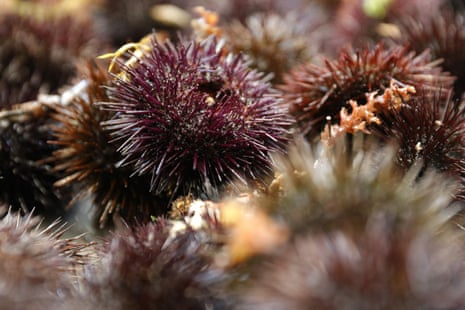Marine biologists at a Florida university say they have solved the mystery of a mass die-off of long-spined sea urchins from the US to the Caribbean.
The scientists blame a microscopic, single-cell parasite for the die-off, which took hold early last year. Affected Diadema antillarum urchins lose their spines and suction, then succumb to disease.
The researchers, from Tampa’s University of South Florida (USF), also suspect the organism, a ciliate known as philaster, may have been responsible for wiping out about 98% of sea urchins in a similar episode in the region in the 1980s.
“I was like, ‘Yes, we have to figure this out,’ because in that 80s die-out, just the loss of this one species of urchin completely changed the fate of coral reefs,” Mya Breitbart, professor of biological oceanography at USF, told the Tampa Bay Times of the day she was invited to research the die-off in March last year.
Breitbart and a team including scientists from Cornell University and the US Geological Survey cracked the case within four months. Their study was published last week in the peer-reviewed journal Science Advances.
They identified the culprit by collecting samples from 23 sites around the Caribbean, including Aruba, the US Virgin Islands and Puerto Rico, and observing organisms attached to the sea urchins, which are known as the “lawnmowers” of coral reefs for their ability to consume decay-causing algae.
They were able to prove philaster was to blame by placing the organism in tanks with healthy, laboratory grown urchins and watching about 60% of the sample die with the same symptoms exhibited in the marine environment.
Breitbart said what surprised them most was the speed at which they were able to home in on the prime suspect.
“All of us on our team have been working on marine diseases for a long time, and this just doesn’t happen. This is really unprecedented to figure it out,” she said.
The cause of the 1980s die-off was not established at the time and may never be known, Breitbart said, because no samples from that outbreak still exist.
But the scientists did identify similarities between the two events, and say the outcome is the same: coral reefs clogged with algae and starved of nutrients, further adding to their precarious state.
Reefs in the Caribbean were already suffering from the fast-spreading and highly contagious stony coral tissue loss disease, scientists warning more than a decade ago that the entire reef system was in danger of collapse.
While there is no known method to eliminate philaster or protect sea urchins from it, Breitbart said, she was hopeful that further research would provide a breakthrough. Her team in Tampa has established a laboratory farm to study the organism, which is not harmful to humans.
“We’re excited to share this information with everyone, from reef managers to additional scientists so we can explore it further and try to stop its spread,” she said.
